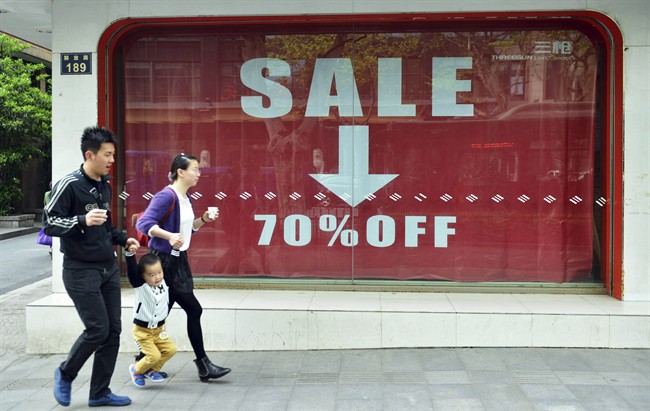BEIJING – China’s economic slump deepened as manufacturing and retail sales cooled in the first quarter of this year, stepping up pressure for Beijing to keep the world’s second-largest economy on track.

Growth declined to 7 per cent from the previous quarter’s 7.3 per cent, official data showed Wednesday. It was China’s weakest performance since the global financial crisis, when growth tumbled to 6.1 per cent in the first quarter of 2009.
Much of China’s decline has been self-imposed as communist leaders try to steer the economy to more sustainable growth based on domestic consumption instead of trade and investment. But an unexpectedly sharp downturn over the past year has fueled fears of job losses and social tensions.
Beijing has cut interest rates twice since November and launched targeted measures to help exporters and other industries. Economists note China still depends on government-led spending on construction to drive growth.
“We still are relying on a traditional growth engine, and that is declining,” said a spokesman for the National Bureau of Statistics, Sheng Laiyun, at a news conference. “We are in transition between the old and new growth models.”
On Tuesday, the country’s top economic official, Premier Li Keqiang, warned at a meeting with businesspeople and economists that China faces “downward pressure,” according to a report on the Cabinet’s website.
Li called for regulatory changes to nurture new industries, improve efficiency and generate jobs, the report said. It made no mention of possible short-term stimulus measures.
- Budget 2024 failed to spark ‘political reboot’ for Liberals, polling suggests
- Train goes up in flames while rolling through London, Ont. Here’s what we know
- Peel police chief met Sri Lankan officer a court says ‘participated’ in torture
- Wrong remains sent to ‘exhausted’ Canadian family after death on Cuba vacation
“Slower growth should not be viewed as bad news if it means the economy is adjusting to a more sustainable path,” said Andrew Colquhun of Fitch Ratings in a statement.
READ MORE: China defence spending to grow 10.1 percent in 2015
“But the adjustment needs support from consumption while the economy adapts to slower investment. It’s sobering that the economy has become so reliant on construction and real estate to generate jobs.”
The country’s leaders have repeatedly affirmed their commitment to a “new normal” of slower growth and say their priority is to make the economy more efficient and productive. Still, the latest performance has been unexpectedly weak, prompting expectations Beijing will be compelled to boost government spending or ease bank lending.
Total trade in the first quarter contracted by 6.3 per cent from a year ago, making it unlikely the ruling Communist Party can meet its target of 6 per cent growth for the year. March exports fell 15 per cent.
Growth in factory output slowed to 6.4 per cent from December’s 9.8 per cent rate, according to Wednesday’s data. Investment in real estate, factories and other fixed assets was 13.5 per cent, down from last year’s 15.7 per cent expansion.
Growth in retail sales slowed to 10.6 per cent from 2014’s full-year expansion of 12 per cent. Even those weakening numbers might fail to give a true picture of the state of consumers’ willingness to spend, because unlike in other countries, China’s official retail data include purchases by the military and government agencies.
Sheng said he had no details of what share of economic growth came from consumption and how much from investment. But he said it should be about the same as last year, when consumption’s contribution to overall economic growth rose above half for the first time, reaching 51.2 per cent.
This week, the World Bank trimmed its forecast for China’s growth to 7 per cent this year from 7.1 per cent. Earlier, the International Monetary Fund cut its own outlook for China to 6.8 per cent from 7.1 per cent.
Those rates are well above the low single-digit growth forecasts for the United States and Europe this year but less than half China’s peak of 14.2 per cent growth in 2007.




Comments